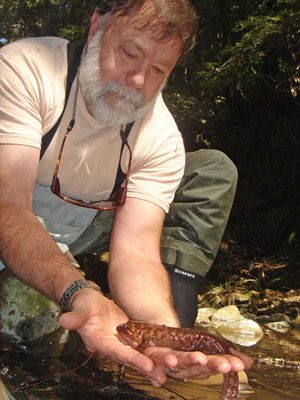
What is it about a river that loves its bend?
For the San Lorenzo River, Rincon (Spanish for bend) is a place where geological treasures and giant granite boulders are unloaded, creating pools, grottos and hideouts for scaly and slimy water creatures.
On a summer’s afternoon, I parked my car at a sign-less turnout on Highway 9 south of Felton on an expedition to find Rincon for myself. Information about its location has been sketchy. Perhaps it is a place where one must be taken.
On the Rincon Fire Road, the forest of evergreens and big leaf maples was quiet, when suddenly I heard a commotion. Down below, the river has been caught in a deep granite gorge (French for “throat”) where it bellows and tumbles in its spiral down to the sea.
Is this the same waterway I have followed since Boulder Creek, where young boys, looking for crawdads, splashed in the sleepy river at Junction Park? Nearing Rincon, the river has transformed itself into the spiritual wildness of Yosemite.
Following the sound of laughter ahead, I turned off the road and down an embankment to Rincon. Girls lounged in bikinis on bulbous boulders and young men climbed a fern-clad cliff and jumped into the deep, green pool below with the bravado of an Acapulco cliff diver.
During the winter rains, a waterfall drops from the cliff and kayakers ply the whitewater rapids. But this is summer, and the only thing moving fast is an occasional swallow. Rincon is where the river has come to play.
As painted sister butterflies wove patterns above me, I noticed that sycamores and willows have lodged themselves into the boulders on the sandy beach for protection against the winter ravages of the river.
As the folksong says, “Like a tree standing by the water, I shall not be moved.”
My friend, Don Alley, has been here many times. As a top fisheries biologist, he knows every waterway from here to San Luis Obispo. Local water districts commission him to survey fish populations, particularly the threatened steelhead, to understand the effects of our water consumption on the river and its tributaries.
Don stuck with his childhood passion, streams, and made it the theme of his life. Today, his home sits just 30 feet from the San Lorenzo River.
When Don and his colleagues go to Rincon, they set up their nets and go electrofishing. The process stuns the fish but does not hurt them. Not only are they counting the fish, but Don can look at a steelhead’s scales and tell how old the fish is.
“It’s kind of like counting rings on a tree,” he laughs.
Steelhead like Rincon, Don says, “because of the long, slow pools and the riffles.”
“A riffle,” according to writer/environmentalist William deBuys, “is the little brother of a rapid. … [It] produces some of the happiest voices of a river, murmuring and chattering.”
Join Don and I on a nature walk to Rincon on Saturday, July 18. You can ask Don about saving red-legged frogs in the moonlight, what he found in a box underwater and other surprises.
Contact me for information. This is a free walk made possible through a grant from the San Lorenzo Valley Water District.
n Carol Carson has been a docent for Henry Cowell Redwoods State Park and has taught courses on Big Basin State Park for UCSC Extension. She volunteers as an environmental educator for the Valley Women’s Club and can be contacted at ca****@*********on.com.












